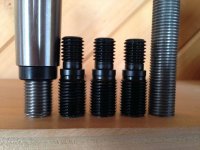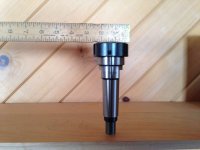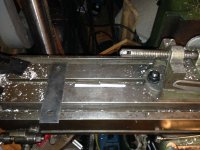traditional-tools
Diamond
- Joined
- Aug 10, 2007
- Location
- West Coast
Ok, this seems very basic, but I don't want to damage anything...
I have the spring collet sleeve in my vertical head, and it is stuck in there solid.
The ring is loose and can be unscrewed just fine, but the sleeve is stuck in the taper solid.
I have tried tapping the edge with a rawhide mallet, nothing. Even tried tapping with a punch to the inside of the ring, of what I felt pretty hard...nothing.
I also tried to wedge a screwdriver blade between the collar and spindle, but that doesn't seem to pry it out either. It is in solid.
I can unscrew the drawbar and the collet drops right out. I can insert/remove the collet with no problem, it's the sleeve that is giving me grief...
Any words of wisdom on removing it?
I will go on record as saying that I am getting to believe that using the spring collets in the MK4 taper is maybe not such a smart idea. If the taper gets stuck, it seems like a big problem. At least the MK4 collets fall out cleanly, as will the MK4 ER-40 collet holder I ordered from Singer...
Cheers,
Alan
I have the spring collet sleeve in my vertical head, and it is stuck in there solid.
The ring is loose and can be unscrewed just fine, but the sleeve is stuck in the taper solid.
I have tried tapping the edge with a rawhide mallet, nothing. Even tried tapping with a punch to the inside of the ring, of what I felt pretty hard...nothing.
I also tried to wedge a screwdriver blade between the collar and spindle, but that doesn't seem to pry it out either. It is in solid.
I can unscrew the drawbar and the collet drops right out. I can insert/remove the collet with no problem, it's the sleeve that is giving me grief...

Any words of wisdom on removing it?
I will go on record as saying that I am getting to believe that using the spring collets in the MK4 taper is maybe not such a smart idea. If the taper gets stuck, it seems like a big problem. At least the MK4 collets fall out cleanly, as will the MK4 ER-40 collet holder I ordered from Singer...
Cheers,
Alan




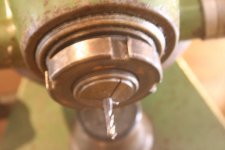
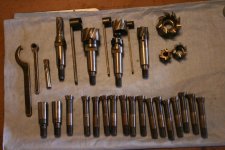


 I'll post as I move forward.
I'll post as I move forward.

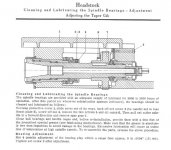


 (I will have a set of those wedges soon).
(I will have a set of those wedges soon).